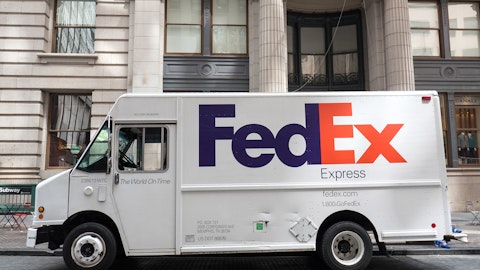Adam Satterfield: Yes. We – from a tonnage standpoint, the sequential increase in September from August was up 2.7%, the 10-year average change is a 3.6% increase. So – but that compares favorably to what our performance has been in the third month of the first few quarters of the year, was the point that I was making. We’ve seen a little bit stronger pickup in September coming to us versus what we had seen earlier in the year and really no new events, if you will, within the industry that were driving any of that change, just a continuation of some of that freight that had to move at the end of July, we had made the point on the last call that obviously, shippers had to find an immediate home for that freight, and they likely leverage the existing carriers that they had in their networks or at least the large national accounts did.
But we believe in and continue to believe that there’s going to be some share shifting around. But I think that especially as we go through the fourth quarter, the first quarter of next year, two periods that are seasonally slower during the year is probably the type of environment that shippers will be looking at their overall supply chain partners and figuring out what’s the right solution to have. And so I think that we’ll see some churn that will be happening over the next six months. I think that there are probably some customers that were at competitors previously that are taking on margin increases right now at a time when their service is probably deteriorating, that it will also be looking at the value that OD can provide. And those are the types of accounts that we’ve seen in prior periods.
It’s obviously, the situation is different, but I think it could be very similar to 2021. That environment was just all demand-driven, but demand was incredibly strong. There is tremendous opportunity there from a volume standpoint. And a lot of the competitors simply couldn’t take on the incremental volumes because they didn’t have all the elements of capacity in place to be able to do so. And they’re missing pickups, They’re not able to get the freight that they do pick up, delivered on time. And those are the types of customers that increasingly call on Old Dominion. And we’re starting to have some of those same types of conversations, maybe not at the same level at this point, but we’re having those same conversations today. And we think that, that will create some incremental volume opportunity for us as we progress through the next few quarters.
Eric Morgan: Thank you.
Operator: The next question is from Ken Hoexter with Bank of America. Please go ahead.
Kenneth Hoexter: Hey, great. Good morning, Marty and Adam. So the market, obviously, at 30x earnings, taking this a little bit in stride here this morning, maybe it’s because the 2%, 2.5% downtick in October, maybe some of the SDs give back expectations. But I guess maybe the expectation was for faster growth and that you’d be able to keep the OR, yet you’re talking about more measured growth. So I just want to dig into this. There was a great discussion with Scott earlier into your outlook and your thoughts on sustained growth. But maybe thoughts about the industry and the competitive nature of it, right? So if you’ve got this bid process on the service centers coming up, which means the capacity just goes elsewhere, it doesn’t go away.
And maybe everybody thought it was going to go away and that would enable you to continue to take that share. Maybe your thoughts on what does that lack of tightening, right, if more of that capacity spills out to the market on your ability to take that? And I know, Adam, you couldn’t give your thoughts on it, but maybe just give the factual stuff, maybe the timing of the service center bids, just so we’re all on top of the exact nature of the distribution of those?
Adam Satterfield: Yes. I think over the next few weeks, bids will be due. And so I think a lot will be determined, obviously, in the next month or so and figuring out who may end up with some of those service centers. I still believe that some of that capacity will be leaving the industry overall. But the reality is all of those shipments that were in place before, it’s been several months now. They found a new home. And so if you’re – someone on the strategic side that might be investing, you’ve got to look and think about how that would make sense, how much incremental capacity do you want to buy that you would have to go out and how would you use it kind of thing. And so those are some of the thoughts that in considerations that I’m sure that we have and that others have as well.
But again, from our standpoint, we believe we continue to grow. We will continue to invest in one shape or form, whether it’s trying to go back after some of these properties in that bid or if it’s something totally independent, which was the path that we were on before they closed their doors. Either way, I think when we think about the long-term, and that’s the lens that we try to view our business through, we believe we will be the biggest market share winner over the next 10 years because of the quality of service that we offer and the value offering that we have in place. That’s going to require investment. Just because you invest doesn’t mean you’re going to go win share. And if someone does, then it’s probably increasing their cost basis.
And that could be a good thing for us as well if our competitors’ costs are increasing, requiring them to increase rates, even further and maybe closing some of that price gap that exists between us and others. So I think that we tried to say on the last quarter call that our approach is going to be more slow and steady, if you will in this environment where underlying demand is – continues to remain relatively consistent. We’ve not seen any type of true inflection in the economy at this point and we’re prepared for it when it happens. And I think we’ve seen some really strong performance in the past when we get into those types of strong demand environment. So we’re ready for it from thinking about all elements of capacity. It’s more than just service centers.




